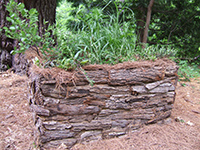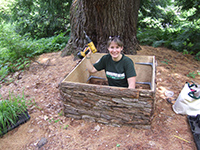| Southeastern Massachusetts Pine Barrens Plants for Pollinators Pollinating insects are needed for about 90% of all plants to reproduce. Many pollinators are specific to certain plants and are essential to maintaining biodiversity. Without pollinators, not only will plants fail to reproduce but food that birds and other wildlife require will disapear too. Help keep the southeastern Massachusetts pine barrens healthy by choosing native flowering plants that are good sources of nectar and pollen. To increase forage for native bumble bees, and other beneficial insects, remove lawns and exotic plants and plant flowering native plants. We recommend planting native plants in clumps of four feet or more in diameter and establishing a variety of flowering native plants to assure blossoms throughout the growing season. If you don't have a large lawn, you can still help the pine barrens by planting in pots! Here is our pine-barren container garden, which has won a prize in the New England Wildflower Society contest and became a part of Container Gardening for Pollinators exhibit at Garden-in-the-Woods. Garden and Forest: Southeastern Massachusetts Pine Barrens Garden Our display is demonstrating a great gardening potential of plants locally native in southeastern Massachusetts, informing homeowners about economical and ecological advantages of using native plants. We hope to prove that local natives can be attractive--for insects as well as birds and humans—and the garden can thus become a continuation of the forest. There is much talk about gardening with natives. However, while analyzing the assortment of native plants in nurseries, one finds out before long that the word “native” most of the time is interpreted in a rather broad sense. “Native” can mean native to North America, to the Atlantic Coast, North Carolina, New England… Even those plants on sale native particularly in our state most often belong in the rich, moist, and shady forests of the Berkshires. This leaves homeowners of southeastern Massachusetts, with its poor sandy soil and dry open habitats, nearly empty-handed. The Friends of Myles Standish State Forest, a pine barren ecosystem on poor sandy soil, the only one such forest in New England and one of the few in the world, have come up with an initiative. We called it Pine Barrens Community Initiative (PBCI). Our goal is to break the current habit of neglecting local natives adapted to dry poor soil and open habitats and ultimately make many of them available for homeowners. Because the majority of local species of SE Massachusetts are not commercially available, we have started our own propagation lines of many local, drought-tolerant, attractive species. Displays of native plants that we are developing in Myles Standish State Forest serve a dual purpose: while promoting natives for gardening, they are, at the same time, our source plantings, providing propagation material, which we can then distribute to others. Irina Kadis
June 9, 2011 DISPLAY DESCRIPTION | 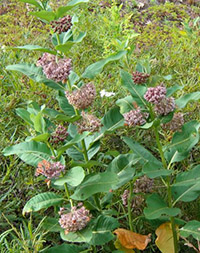
common milkweed (Asclepias syriaca) | 1. The centerpiece of the composition is common milkweed (Asclepias syriaca). (Other milkweed species, such as wavy-leaved milkweed, A. amplexicaulis or butterfly weed, A. tuberosa could also serve this purpose very well.) By including common milkweed, we’d like to demonstrate that being common does not mean being less attractive.
We don’t have to advertize Asclepias’ ability to attract insects! Milkweed intrinsic flowers are pollinated mainly by bees and bumble-bees. Nowadays 99% of pollinators are exotic honey bees (Apis melifera). The principal pollinators during pre-settlement times might be bumble-bees (Bombus), thread-waisted wasps (Sphex, Tacytes), and paper wasps (Wespidae). Leaves, flowers, seeds, stem juice, and roots of milkweeds attract multitudes of other insects including red milkweed beetle Tetraopes (Cerambycidae). Milkweeds contain cardiac glucosides, which are accumulated in bodies of feeding insects producing the bright red color. It plays a protective role letting predators know that the beetle is distasteful. | 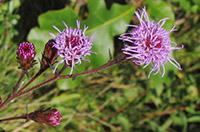
New England blazing star (Liatris scariosa var. novae-angliae) | 2. The other ‘star’ of the exhibit, the one succeeding milkweeds in flowering, is New England blazing star (Liatris scariosa var. novae-angliae). Despite plenty of habitat, this showy plant has become increasingly rare in our state and particularly in Myles Standish State Forest. Meanwhile, it is destined to become a signature plant of dry habitats in eastern Massachusetts. Its pollination is mediated by bees, flies, butterflies (including monarch), and moths. In order to encourage it along roadsides, the fall mowing has to be postponed until after the time blazing star disperses its seed in October. | 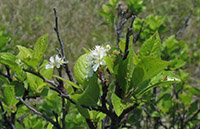
beach plum (Prunus maritima) | 3. A shrub clump is composed of the northeastern Atlantic Coast celebrity, beach plum (Prunus maritima), whose flowering and cross-pollination take place early in spring, before the leaves. The pollen is delivered either by wind or bees. The most common pollinators are honey bees, followed by wild bees, bumblebees, and syrphid flies. Ripening at the start of the fall, plums are highly attractive both to wildlife and humans. Beach plum crooked branchlets and shiny leaves are adding character to the composition, but also providing some shade for # 4. | 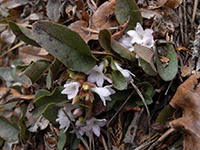
trailing arbutus or mayflower (Epigaea repens) | 4. The state flower of Massachusetts, trailing arbutus or mayflower (Epigaea repens) is a semi-shade prostrate plant, whose prime habitat is old white-pine forest. Its flowering time is early in spring; the attractive foliage holds throughout the growing season and in protected habitats looks good even in winter! Trailing arbutus is pollinated by a variety of insects including ants. Of the plants represented in our composition, this is the most difficult to grow. | 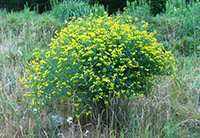
yellow wild indigo (Baptisia tinctoria) | 5. A joyfully looking leguminous annual, yellow wild indigo (Baptisia tinctoria), is widely distributed in eastern North America: all the way from eastern Canada to Florida. While it is common in Massachusetts, wild indigo is rare or endangered in some other states, such as Maine. The artichoke-looking juicy, bluish stems emerge early in spring; by the start of summer the plant becomes bushy, looking like a large yellow balloon—all covered by abundant bright yellow flowers. Pollination is mostly by bees. Wild indigo is the only food of wild-indigo duskywing butterfly (Erynnis baptisiae) in its larval stage. Other butterfly larvae, such as sleepy duskywing (Thanaos brizo), Io moth (Automeris io), and frosted elfin (Callophrys irus) also feed on yellow wild indigo. One of the plant’s common names, “horsefly weed,” is explained by its former usage as a horsefly repellent. | 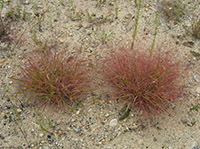
purple lovegrass (Eragrostis spectabilis) | 6. The background is formed by native grasses: a common colorful low grass of dry habitats, purple lovegrass (Eragrostis spectabilis) and switchgrass or tall panic grass (Panicum virgatum). As every grass, both are wind pollinated. Switchgrass used to be cultivated as forage grass and thus became widespread. This spectacular prairie plant has moved to the northeast and now grows here in large clumps on sandy soil. Bushy purple clumps of lovegrass become very conspicuous in August-September along highways, on open sand, or at any sunny disturbed habitats with sandy or rocky soil. This low perennial grass produces a disproportionally huge inflorescence, which eventually breaks off. Seeds then travel around on this tumbleweed. | 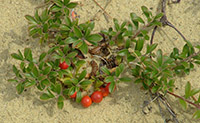
bearberry (Arctostaphylos uva-ursi) | 7. A nice alternative for alien groundcovers, such as periwinkle or pachysandra, bearberry (Arctostaphylos uva-ursi) can serve as a perfect, care-free, all-season natural groundcover, particularly for open, barren lots on poor sandy soil, where hardly any other plant would survive. Mending gaps with its long prostrate shoots, it will gradually spread over the sand and eventually form continuous robust and shiny groundcover. Over the winter the foliage turns dark red-brown. Urn-shaped pink flowers occur in May. There are different opinions about the process of pollination, a variety of agents being named--from wind to bees and thrips. It is also known to be self-compatible. Bright red fruit dot the foliage from late summer into the fall, sometimes holding on over the winter. The berries look good, though are dry and tasteless. This valuable medicinal plant can be used as tea for kidney problems. | Photos courtesy of Alexey Zinovjev and Irina Kadis.Visit www.salicicola.com where you can see hundreds of Alexey's and Irina's pictures and descriptions of wildflowers and plants. | | Melissa Guimont helping Irina build the container for the New England Wildflower Society Garden in the Woods Native Buzz exhibit. | | Container garden complete. | 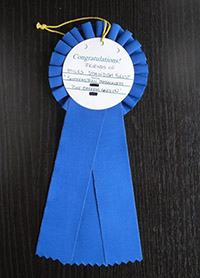 | New England Wildflower Society 1st Place Ribbon for "Southeastern Massachusetts Pine Barrens Garden." | 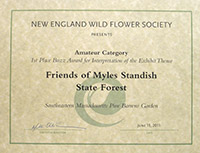 | 1st Place Buzz Award for Interpretation of the Exhibit Theme. | Myles Standish State Forest Headquarters, Cranberry Road, S. Carver, MA 02366 (508) 866-2526 
Department of Conservation and Recreation Myles Standish State Forest web site click here. | |

